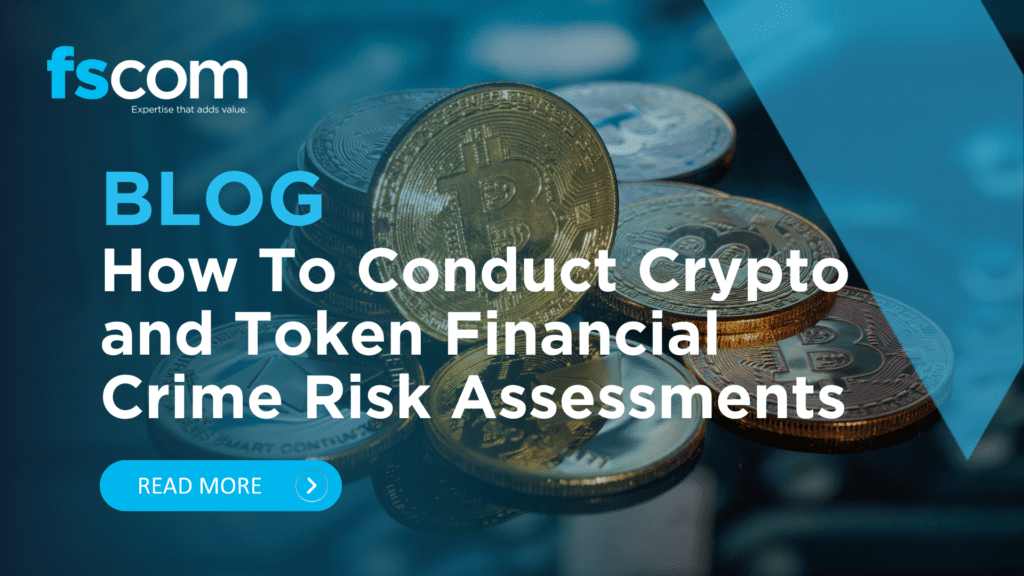
Cryptocurrencies have exploded in recent years, and criminals have noticed. $3.5 billion was laundered through cryptoassets in 2020, bringing a heightened regulatory focus and new risks for Virtual Assets Service Providers (VASPs) who offer cryptoasset products and services, or any company doing business with one.
In this blog, Chris Vaughan, formerly a financial crime risk manager working in cryptoassets and now Senior Compliance Associate at fscom, explains how firms should carry out risk assessments to understand and mitigate the financial crime risk from cryptoassets and tokens.
Risk assessments: the core of an effective crypto AML strategy
Any compliance professional will tell you that a risk assessment is an essential tool in the fight against financial crime, so this is where a crypto AML strategy should start. An effective risk assessment is the first step in building a framework because it allows companies to identify the risks they face and decide the appropriate controls to mitigate those risks. A risk assessment is particularly useful for VASPs because:
As a starting it’s good to ask, what might we want to risk assess? We recommend firms look at four main areas:
There are many categories of cryptoassets, from payment and exchange tokens like Bitcoin to Non-Fungible Tokens. A token risk assessment should understand what each kind of token does, assess the risk of that token being used as a vehicle for money laundering and terrorist financing, then apply controls to mitigate this risk.
Crypto products and services are usually classified as on-ramp or off-ramp depending on whether a client is buying or selling assets . A risk assessment should understand the inherent risk factors in each of these areas.
Firms servicing the cryptoasset sector should risk assess the VASPs they serve as clients and identify their risk factors. This could include a number of factors including the jurisdictions in which the VASP and/or its customers are based, the cryptoassets it offers, the size and nature of its clients, and the extent to which it is regulated.
Customers of VASPs should also be assessed to determine their risk level. This will vary according to the jurisdiction where they live, whether they are a corporation or an individual customer, the services and assets they use and their transaction activity among other factors.
The final stage of a risk assessment: implementing controls
Once a risk assessment has been carried out and the threat level determined, firms then need to decide which controls to implement to best manage and mitigate cryptoasset risk. These will vary according to the level of risk and the type of token, VASP, product or customer being assessed. But there are common controls that firms should consider implementing, including:
The crypto industry is not likely to stand still any time soon, and cryptoassets will continue to be a growing target for prospective money launderers. Regulatory focus is only likely to increase, but whatever happens, companies who have carried out an effective risk assessment will be best prepared to manage any new risks that emerge.
The Payments Association
St Clement’s House
27 Clements Lane
London EC4N 7AE
© Copyright 2024 The Payments Association. All Rights Reserved. The Payments Association is the trading name of Emerging Payments Ventures Limited.
Emerging Ventures Limited t/a The Payments Association; Registered in England and Wales, Company Number 06672728; VAT no. 938829859; Registered office address St. Clement’s House, 27 Clements Lane, London, England, EC4N 7AE.







Log in to access complimentary passes or discounts and access exclusive content as part of your membership. An auto-login link will be sent directly to your email.
We use an auto-login link to ensure optimum security for your members hub. Simply enter your professional work e-mail address into the input area and you’ll receive a link to directly access your account.
Instead of using passwords, we e-mail you a link to log in to the site. This allows us to automatically verify you and apply member benefits based on your e-mail domain name.
Please click the button below which relates to the issue you’re having.
Sometimes our e-mails end up in spam. Make sure to check your spam folder for e-mails from The Payments Association
Most modern e-mail clients now separate e-mails into different tabs. For example, Outlook has an “Other” tab, and Gmail has tabs for different types of e-mails, such as promotional.
For security reasons the link will expire after 60 minutes. Try submitting the login form again and wait a few seconds for the e-mail to arrive.
The link will only work one time – once it’s been clicked, the link won’t log you in again. Instead, you’ll need to go back to the login screen and generate a new link.
Make sure you’re clicking the link on the most recent e-mail that’s been sent to you. We recommend deleting the e-mail once you’ve clicked the link.
Some security systems will automatically click on links in e-mails to check for phishing, malware, viruses and other malicious threats. If these have been clicked, it won’t work when you try to click on the link.
For security reasons, e-mail address changes can only be complete by your Member Engagement Manager. Please contact the team directly for further help.